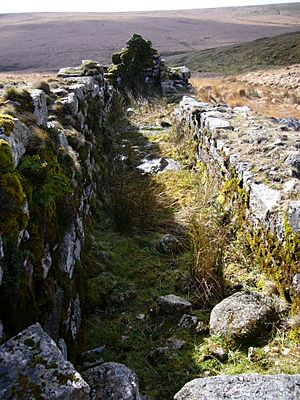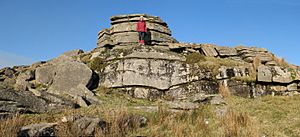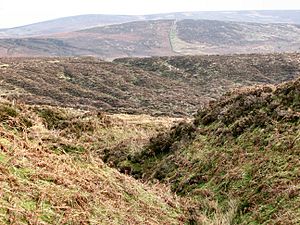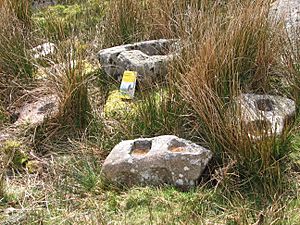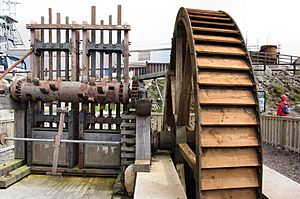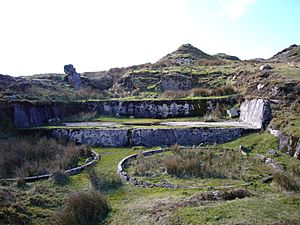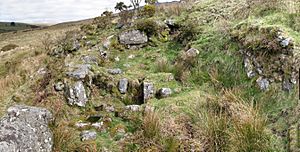Dartmoor tin mining facts for kids
Tin mining on Dartmoor, Devon, England, has a very long history. It started even before the Roman Empire and continued until the 20th century. The last big tin mine, Golden Dagger Mine, closed in 1930.
From the 1100s, tin mining was controlled by special rules called Stannary law. These rules were made by a group called a stannary parliament.
Tin metal comes from a mineral called cassiterite. This mineral is found in granite rock. Dartmoor was a great place to find it. Miners used different ways to get tin over time. They started by "streaming" in rivers, then dug "open cast" mines, and finally dug "underground" mines.
Today, you can still see many old mining sites on Dartmoor. These show how tin was dug up and processed.
Contents
What was Stannary Law?
Tin mining was so important that miners created their own laws. These were called stannary laws. They even had their own parliaments, called stannary parliaments. These special laws applied to everyone involved in the tin industry.
King Edward I set up stannaries in Tavistock, Ashburton, and Chagford in 1305. Plympton was added later. The Devon stannary parliament met outdoors at Crockern Tor starting in 1494.
If someone broke a stannary law, they could be sent to jail in Lydford. These special courts stopped being used in 1836.
Where was Tin Found?
Most tin mines on Dartmoor were in granite rock. The tin was usually found in long cracks in the rock called "lodes." These lodes often ran from east-northeast to west-southwest.
The tin ore, cassiterite, was often mixed with other minerals like tourmaline. In central Dartmoor, it was also found with shiny haematite. In the southern part of Dartmoor, the tin grains were quite large. However, the amount of tin in the lodes varied a lot.
Miners found that digging very deep was not usually profitable. Long ago, a lot of tin ore was washed into rivers. This created "alluvial deposits" that were easier to mine first.
How was Tin Mined?
Streaming: Early River Mining
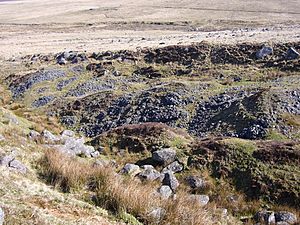
The oldest way to get tin was called "streaming." Miners collected tin from riverbeds. The tin had washed down from the lodes over time. This process created very pure tin gravel.
This tin gravel was mixed with unwanted minerals like quartz. Tin is much heavier than these other minerals. So, miners used water to separate them. They would pass a stream of water over the gravels. The lighter unwanted minerals would wash away faster.
Once a tin-rich valley was found, miners would bring water using a channel called a leat. They dug a trench at the lowest end of the deposit. This trench, called a "tye," helped wash away the fine, unwanted material. Then, they worked their way up the valley. They used picks to loosen the riverbed and water to wash away the debris.
This method left special marks on the land. You can still see ridges of larger, unwanted rock. These ridges are sometimes straight, sometimes wavy. They are always next to a steep edge, which shows where the digging stopped.
Tin was also found in "eluvial deposits." These were places where tin had weathered out of the rock but hadn't been carried by water. These deposits were usually not as rich. They also didn't have as much water nearby to help with the separation. Miners often built reservoirs to collect rainwater for these sites.
Studies show that tin mining was happening in the Erme valley between the 4th and 7th centuries. This means tin mining was active in late Roman or early post-Roman times. Written records confirm a big increase in tin production in the 13th century. The first written record of tin streaming is from the 12th century.
Open Cast Mining: Digging from the Surface
By the 1400s, it was harder to find tin in streams. But people still wanted a lot of tin. So, miners started digging directly into the lodes from the surface. This was called "beamworks." The huge gullies left by this method are still easy to see on Dartmoor today. Some of these gullies still have "beam" in their names, like Gibby Beam. They are also known as "openworks" or "gerts."
Another surface mining method was "lodeback-work." Miners dug pits along the lode. Sometimes, they dug pairs of pits and followed the lode underground between them. This might have led to the beamworks method later on.
Just like with streaming, miners used a lot of water for open cast mining. Water helped wash away the unwanted rock and soil. Miners would loosen the soil with picks. Then, water would carry away the unwanted material. They built complex systems of reservoirs and channels to collect and store water.
Underground Mining: Going Deeper
The Dartmoor tin industry became less important in the early 1700s. By 1730, it had almost stopped. This was mainly because the easy-to-reach tin was gone. Mining only started again when the Industrial Revolution created a huge demand for metals. New technology also made deeper mining possible.
Underground mining had existed for centuries. But the hard granite rock and a lot of underground water made deep mining difficult. It wasn't worth it until the late 1700s.
Many small mines opened on Dartmoor in the late 1700s and 1800s. About 48 mines produced some tin during this time. Many of these mines were not successful. They were often given hopeful names like Wheal Fortune or Wheal Lucky. "Wheal" is an old word meaning "mine" or "works." However, some larger mines, like Eylesbarrow mine and the Vitifer – Birch Tor complex, produced tin for many years.
Most underground mines dug into lodes that had already been mined from the surface. Because there was so much underground water, miners had to dig horizontal tunnels called "adits." These adits helped drain water out of the mines. Dartmoor's deep valleys helped, as adits could be dug into hillsides. These adits connected to vertical shafts or shafts that followed the lode. Miners then dug out the lode from these horizontal levels.
When miners needed to go deeper than the lowest adit, they had to pump out water. Large waterwheels were used for this. If the shaft was higher than the water supply, the waterwheel was placed lower down. Power was sent up to the shaft using a "flatrod" system. You can still see evidence of these systems today. They look like double rows of stones with grooves on top. These held the pulleys that guided the metal rods. Examples can be seen at Eylesbarrow and Hexworthy.
In the late 1800s, a lot of tin was found in Malaya. This greatly affected the Dartmoor industry. Many miners moved away. The last tin mine on Dartmoor closed just before the Second World War. However, Hemerdon Mine was later mined for tungsten and tin in the 1980s. It reopened in 2015.
How was Tin Processed?
After collecting the tin ore, it had to be crushed, cleaned, and then melted. Over time, these steps became more advanced.
Crushing the Ore
Early miners used a hard stone as a mortar and another stone or wood as a pestle. They broke up the ore when needed. But rich tin gravels often needed little crushing. Later, a method called "crazing" used two round stones, like millstones. The top stone spun on the bottom one. Coarse gravel or crushed ore was put in the middle. It was ground into fine sand. Only three crazing mills have been found. At Gobbet mine, both stones are still visible.
As miners needed to process larger pieces of ore, "stamping" was introduced. This used vertical hammers powered by a waterwheel. These were called Stamp mills. At least 60 of these mills existed on Dartmoor. The first record of a stamping mill on Dartmoor is from 1504. They were probably used even earlier. Stamping mills were also called "knacking" or "knocking" mills. Knacking Mill Gulf on the River Erme shows where one once stood.
The hammers, or "stamps," were heavy wooden beams with iron bottoms. Cams on the waterwheel shaft lifted them. They then dropped repeatedly onto the ore, which lay on a granite block called a mortarstone. Usually, two or three stamps worked in a row. They were powered by the same waterwheel.
At first, this was a dry process. Ore was shoveled in and removed by hand. But in the 1500s, a new idea came from Europe. The stamp heads were put inside a wooden box. This box had a finely perforated screen at one end. Water washed the ore into the box. It also washed out the crushed ore once it was fine enough to pass through the screen. This was a huge improvement. It was a continuous process and stopped unwanted fine dust.
You can tell where a stamping mill once was by finding the mortarstone. These are granite blocks up to a meter long. They have flat faces with two, three, or sometimes four round or oval hollows. These hollows are about 17 cm wide and up to 10 cm deep. Many mortarstones have hollows on more than one side. This shows they were flipped over and reused when the hollows got too deep.
In the 1700s and 1800s, the technology improved. More stamping heads were added. The granite mortarstone was replaced with a thick bed of crushed quartz in a masonry or iron box. By the 1900s, many types of stamps were used, like Cornish and Californian stamps.
Concentrating the Ore
Even pure tin grains from streaming needed cleaning. Unwanted "gangue" material had to be removed before melting the ore. This process was called "dressing the ore." It became even more important when miners started using poorer sources of tin.
The main idea of concentration was simple. It used the big difference in specific gravity (how heavy something is for its size) between tin ore and the gangue. Many different machines were used. These included rectangular and circular buddles, Wilfley tables, and revolving slime tables.
An early method was the rectangular buddle. This was a slightly sloped surface. Crushed material was washed over it with a gentle stream of water. The heavier tin ore settled near the top of the slope. The lighter material settled lower down or washed away. The miner had to decide where to separate the good material from the waste. Often, it was divided into three parts: "heads" (best quality), "middles" (often reprocessed), and "tailings" (waste).
Around 1848, a circular buddle was introduced. Crushed ore mixed with water was poured onto a central cone. It spread outwards over a slightly sloped cone-shaped surface. The "heads" settled near the center. The "tailings" settled at the outer edge. The big improvement was a set of arms that rotated above the buddle. These arms had brushes or fabric that dragged across the surface. This kept the material moving. It stopped water from forming channels and helped separate the tin better. The buddle ran until the deposit was 15 to 30 cm deep. Then, the deposits were dug out in three parts. The "middles" were often processed again in another buddle.
Smelting: Making Metal
The first way to get metal from tin ore needed two melting steps. The first melting was done near the streamworks, often just using a fire. The second melting was done in one of the Stannary towns. We don't know many details about these early methods. But old documents mention taxes on both meltings.
Around 1300, the efficient blowing house process was introduced. This allowed tin to be melted in just one step. Later, reverberatory furnaces were also used. Both types of furnaces were used at Eylesbarrow mine in the early 1800s. This was the last place on Dartmoor where tin was melted.
What were the Effects of Mining?
The large amount of early tin streaming had an impact on the coast. Several harbors filled up with fine material washed down the rivers. Because of this, in 1532, a Stannary Court rule said that all waste should be put in "old Hatches, Tipittes, miry Places, or other convenient Places" away from the main streams.
The signs of mining are still very clear on the Dartmoor landscape. Walkers often find ruined blowing houses. They also see mortar stones with rows of round hollows where ore was crushed. Many of the later mine shafts have been filled in. But a few still remain, fenced off to keep people and animals safe.
The Three Hares Symbol
The three hares is a circular design. It appears in holy places from the Middle East to churches in southwest England. In England, it is often called the "Tinners’ Rabbits." It is most common in churches in the West Country of England.
You can see this design in carved wood, carved stone, window patterns, and stained glass. In southwest England, there are almost thirty examples of the Three Hares. They are often found on 'roof bosses' (carved wooden knobs) on the ceilings of medieval churches in Devon. Many are on Dartmoor. A good example is at Widecombe-in-the-Moor, Dartmoor. Another is in the town of Tavistock.
"Tinners' Rabbits" is also the name of a dance. It involves sticks and three, six, or nine dancers moving in a circle.
See also
- Buddle pit
- Hydraulic mining
- Hushing
- Tin sources and trade in ancient times


